The 2019 NCAA baseball season kicks off in exactly 20 days. And in Columbus there’s high anticipation, as always…tempered by one question of obvious overtone. Who’s going to pitch, and how well?
 Columbus – They start from an impressive cornerstone. Last season the Ohio State Buckeyes rebounded in magnificent fashion from an 11th place finish in 2017, and largely by posting a team batting average that hovered around the .300 mark for two-thirds of the season.
Columbus – They start from an impressive cornerstone. Last season the Ohio State Buckeyes rebounded in magnificent fashion from an 11th place finish in 2017, and largely by posting a team batting average that hovered around the .300 mark for two-thirds of the season.
They flipped the 2017 record of 24-36 by going 36-24, and improved their overall Big Ten standing from 11th to 7th, qualifying for the post-season Big Ten Tourney and the NCAA regional in Greenville, North Carolina.
That’s their building block and it also cuts to the quick of the upcoming year. The Buckeyes scored a lot of runs last season, but they gave up a lot of runs, as well. Defense was horrible in spurts, at times – almost inexplicable.
Their pitching was a work in progress almost from the word ‘go’, centered around starters Ryan Feltner (5-5, 4.52), Connor Curlis (7-4, 3.55), and Adam Niemeyer (4-3, 6.24). The bullpen was another story, anchored by the indefatigable Seth Kinker, a second team All-American who pitched 63 innings while compiling a 7-2 record and a team-leading ERA of 2.27. Behind him…it was a scramble at times.
But time, and experience, is the great healer in baseball. And in college baseball you can add recruiting to that remedy. Greg Beals and his staff have recruited hard and hardy over the past two seasons, bringing in arguably the best athletes and the best pitching prospects in his nine seasons as head coach.

The Bowler’s Store, in Versailles, Ohio, is a proud sponsor of Buckeyes sports on Press Pros Magazine.com.
“We’re excited to get started,” Beals said after fall baseball, in December. “We’re excited because we have quality people all over the field, and we’ve recruited quality pitching prospects that we feel can come in and help us quickly.”
“And,” he continued, “…we’re excited over what we saw in fall baseball. We lost some very good people to graduation and the draft (Feltner, Curlis, Tyler Cowles and Noah McGowan), but last year’s experience and fall ball showed maturity in some of the people in line to step up and take their place. That makes it exciting.”
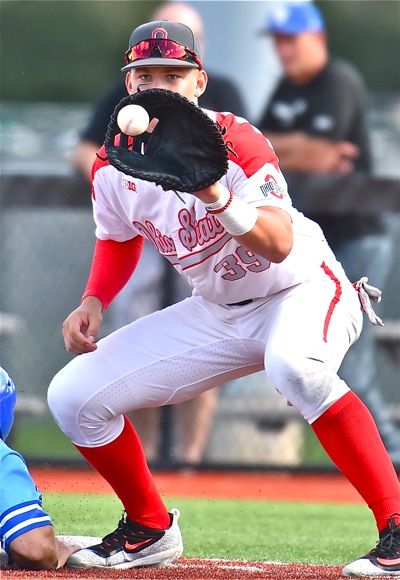
Then third, now first…Conner Pohl moves across the infield to first base to help upgrade the defense in 2019.
Without question the number one priority on the field in fall baseball was how to improve defensively.
“We worked hard to address it,” says Beals. “But what we really worked hard at was to change the mindset. And what we told guys was just go out and make a play, without worrying about making an error.”
Be more athletic and less mechanical, in layman terms. If see the ball, hit the ball, works on offense…then why won’t see the ball, catch the ball, and throw the ball work just as well on defense?
And, there were transitions. Last year’s third baseman, junior Conner Pohl, is this year’s first baseman. At 6’5″ and 225 pounds he physically meets the eye test.
“We like him at the position,” says Beals of the Arcanum, Ohio native, who struggled defensively on the hot corner, committing 18 errors in 60 games – many of them throwing errors. “His size over there presents a great target, plus he showed a very good glove in fall ball. He’s played the position before, he feels comfortable there, and we think the move will also help him at the plate.”
After hitting around .300 for the first half of 2018, Pohl, one of the program’s best personalities and a vicious line-drive hitter, slumped noticeably in the last month, and through the Big Ten and NCAA tourney.
“We think first base is a more natural position for him and that will take some stress off at the plate, as well,” says Beals.
Second base is squarely on the shoulders of senior Kobie Foppe, who hit .335 in 55 games last season. The Phoenix, Arizona native earns praise from the man that counts most. Foppe is a producer, one of 2018’s most consistent players, and there’s little doubt that he won’t be again.
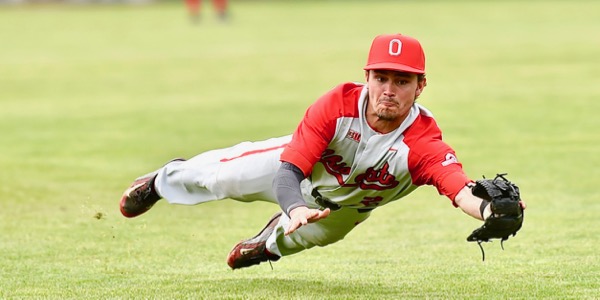
Senior Kobie Foppe returns at second base. “Kobie Foppe is a producer,” says coach Greg Beals.
Shortstop was assumed in mid-season last year by then sophomore Noah West, who took to everyday play like a duck to water. He committed just 7 errors in 114 chances (.963), the highest fielding average of all the Buckeyes infielders. Plus, he hit better, driving his first home run as a collegian out of Bill Davis Stadium in a win over Purdue, while hitting .223 overall.
“There were times when no one could get him out,” says Beals. “And of all they guys who played well in fall baseball, Noah just looked comfortable at shortstop. We expect him to be very good for us in the spring.”
Third base was one of the positions of greatest interest in fall ball, and freshman Zach Dezenzo (Alliance, Oh) made it interesting. At 6’4″ and 195 he moved well, proved that he could pick it and throw, and made steady contact at the plate. To paraphrase the coach, he gets a long look as this year’s third baseman, come February and March.
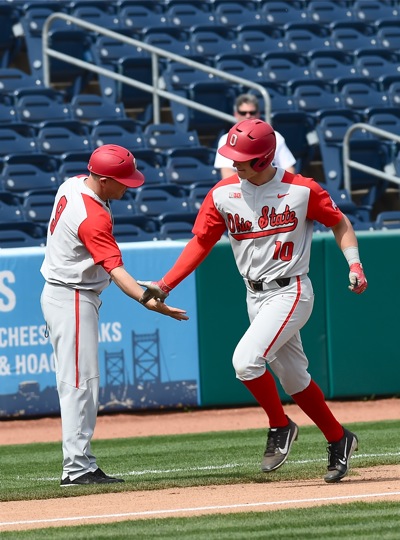
Sophomore captain Dillon Dingler’s four home runs in 2019 came at dramatic times. He’ll move back to his natural position as the Buckeyes’ catcher in 2019.
The catching position is perhaps the strongest position in the infield, anchored by sophomore Dillon Dingler (one of the team’s best overall athletes), and redshirt sophomore Brent Todys, from Westerville, Ohio.
Dingler hit .244 with four home runs as a catcher/centerfielder in 2018, but hit the ball harder than his average reflects. And as a catcher, NO ONE in the Big Ten catches the ball, or throws it better, than the Massillon native.
“He’s only going to get better with more work,” says Beals, who caught for three years in the New York Mets organization. “And having Todys is a big plus because he played and hit consistently in the fall, and that gives us a chance to rest Dillon.”
And there’s adequate depth at hand – Matt Carpenter, and freshmen Marcus Ernst, Nick Erwin, and and Aaron Hughes are in the wings. Senior Andrew Fishel has proven to be a steady backup behind the plate and in DH and pinch-hit duties.
The issue of the outfield is not so clear cut.
Only Dominic Canzone in right field is bankable at this point. The Buckeye junior is going to play solid defense, he can play in center if called upon…and you know he’s going to hit .325, hit a proportionate number of homers, and drive in 35 runs. He’s that good, and he’s that respected across the conference.
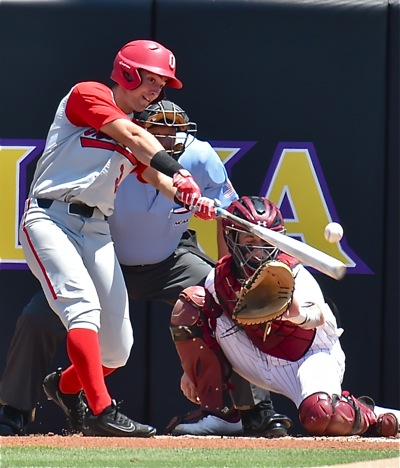
Right fielder Dominic Canzone is one of the NCAA’s best hitters and returns as a captain for his junior season.
Left field is a platoon scenario at this point, with seniors Nate Romans (a 2019 co-captain), who showed surprising power and hard contact last year (3 HRs, .431 slugging pct., and 12 RBIs in 72 ABs). But the surprising other candidate to play out there with Romans…is senior Brady Cherry, who had a disappointing year at the plate in 2018 (.226, 3 HRs, and 57 strikeouts in 159 ABs) while making the initial transition from third base to second.
“It’s a position we’ll watch closely,” said Beals after fall ball. “But we liked what we saw in fall ball and Brady has earned the opportunity because he’s worked so hard. And, he has a power arm and could help us on the mound, as a reliever.” That experiment looked promising in the fall.
Center field? Senior Malik Jones will probably have first dibs to prove that his speed, instinct, and “general peskiness” can make him a Big Ten centerfielder. “He had a good fall,” said Beals. “And we asked him to just be the kind of player offensively that he can be. If he can get on base he’s pesky for his ability to steal a base, take the extra base, and produce runs. That’s what we want to see.”
In the wings…fifth-year senior Ridge Winands (a 2019 co-captain) was valuable in 2o18 and proved that he’s more than capable with the glove in the middle of the outfield. Redshirt freshman Jake Ruby returns, and freshman Nolan Clegg, and sophomore Scottie Seymour made good impressions during the fall.
Again, the issue should not be scoring runs. The issue with this much of our outlook is how to save runs with the eight position guys on the field.
And as to the even bigger issues of pitching….we’ll address that in Part II, to come later in the week. Until then, oil your glove, check your supply of sun screen, and if you’re really into it check air rates to Florida and Texas. We’ll all know soon enough, when they move from the drawing board…to the diamond.
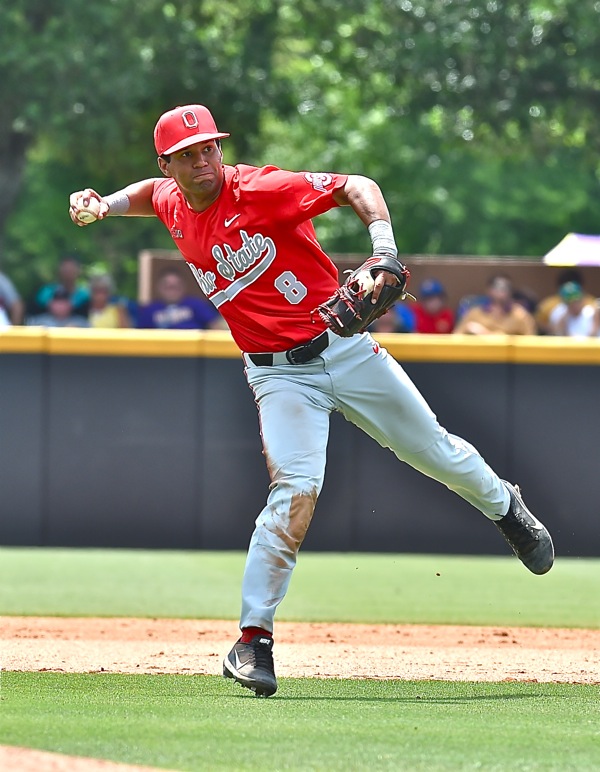
Better defensively...Junior Noah West came on strong in last year's second half to play some of the Big Ten's best shortstop. He'll be a building block in a revamped infield in 2019. (Press Pros File Photos)


